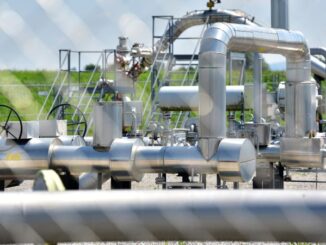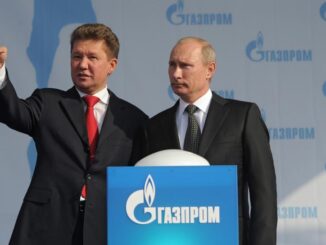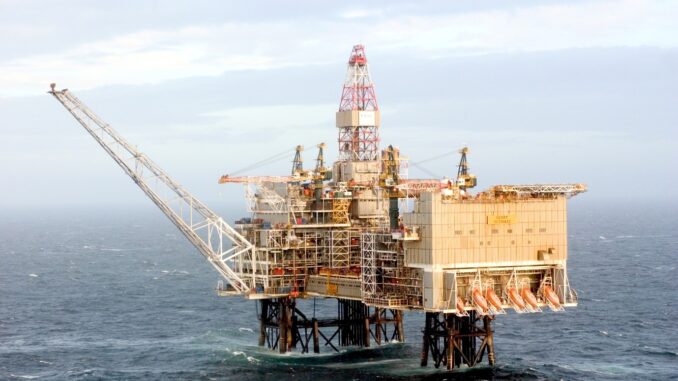
1. As TMX Starts Line Fill, China Takes Centre Stage
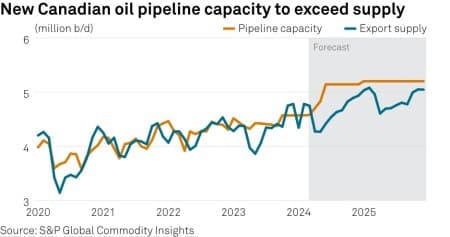
– Canadian crude will start flowing to China directly (up until now it has only been exported from the US Gulf Coast) as the impending launch of the Trans Mountain Expansion pipeline saw the first deals being made.
– Chinese refiner Sinochem bought the first ever TMX cargo, an Aframax worth of heavy sour Access Western Blend at the equivalent discount of $5 per barrel to August ICE Brent futures on a delivered basis.
– Canadian crude exports are set to surpass the 5 million b/d threshold by 2025, with oil producers at last having the optionality to send their barrels to the US Gulf Coast or to TMX as pipeline capacity moves above production at 5.2 million b/d.
– Canada will need new pipelines to meet its production growth, however with TMX taking 12 years to complete and requiring an ownership switch from Kinder Morgan to the government, we might see another infrastructure bottleneck shaping up by the end of this decade.
2. China Binges on Russian Oil as Indian Demand Hits Headwinds
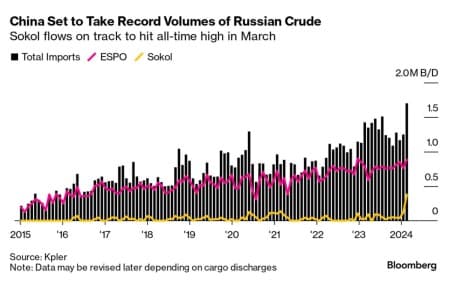
– China is on track to buy the highest-ever volume of Russian crude in March, boosted by the rerouted flows of Sokol, a grade that for most of 2023 was supplied to Indian refiners.
– According to Kpler data, Chinese refiners will receive 1.7 million b/d of Russian crude from the seas, that’s over and above the 0.8 million b/d they receive via pipelines, with Sokol imports reaching almost 400,000 b/d, double the grade’s usual monthly production.
– As Sokol has been trading at Brent parity recently and is evidently above the price cap, a backlog of cargoes built up off Singapore and South Korea over January-February, some 18 million barrels, most of which have cleared to China now.
– With India’s largest refiner Reliance reportedly shunning deliveries using Russian shipping company Sovcomflot, China might buy even more Russian crude over the upcoming months.
3. Middle Eastern Diesel Exporters Find Their Way Back to Europe
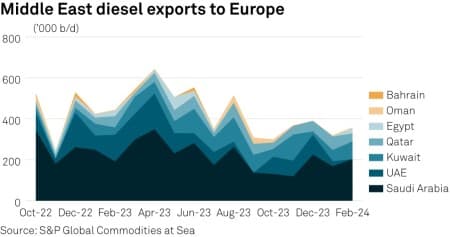
– Disrupted by the naval warfare in the Red Sea between Houthi rebels and the US-led coalition under Operation Prosperity Guardian, diesel flows from the East of Suez have started to recover lately as both the Middle East and India weigh the risks of resuming flows through the Suez Canal.
– Middle Eastern exports of diesel averaged 460,000 b/d in February, the highest in six months, with Saudi Arabia remaining the largest supplier but also the UAE resuming exports after maintenance at its Ruwais refinery.
– India has boosted its diesel exports to Europe as well – following a two-year low of just two tankers (equivalent to 55,000 b/d) in January, last month saw nine tankers sailing towards European buyers, most of which transited the Red Sea and Suez Canal.
– Recent Ukraine drone attacks on Russia’s refineries might pull Middle Eastern diesel barrels to Africa and Latin America, too, as Russian supplies are expected to edge lower.
4. Uranium Prices Dip, However Market Still Upbeat on Weak Supply Outlook
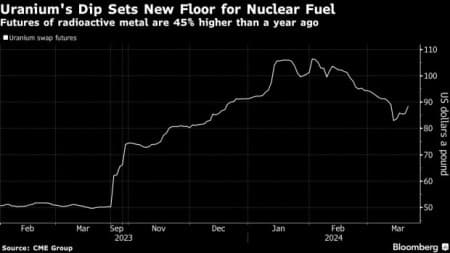
– Uranium prices have pulled off a stellar rally into late 2023, but that heat has cooled off over the past six weeks as U308 futures trading at the New York exchange dropped 22%, currently at $89 per pound.
– The uranium industry remains bullish on the radioactive metal’s outlook, believing the $85-90/lb is uranium’s new price floor and that long-term concerns about supply will prompt another rally soon.
– The world’s largest uranium miner, Kazakhstan’s Kazatomprom, indicated this week that it expects a 21 million pound supply deficit in 2030, expanding further to 147 million pounds by 2040, a reflection of a decade-long lack of investment into new projects.
– The rise of geopolitical tensions might also affect uranium prices; the market expects a notable boost to U308 futures should the US Senate pass a proposed bill for the United States to ban Russian uranium imports.
5. Australia Needs Investment to Remain a Top LNG Exporter
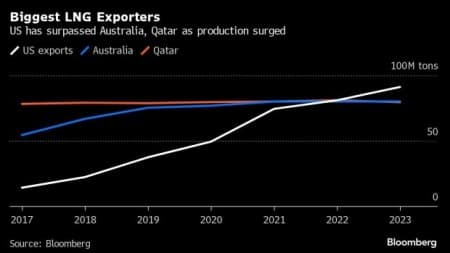
– Australia’s electricity grid operator AEMO signalled that the country urgently needs investment to avoid shortfalls in supply from 2025 onwards, calling for higher penetration of renewables and higher gas production.
– The southern states of Australia, home to two-thirds of the population, are currently phasing out their coal plants, the backbone of the regional grid for decades, with AEMO forecasting a gap in gas supply from 2028 onwards.
– Australia’s upcoming gas projects are mired in protracted lawsuits – Santos spent 18 months fighting off litigation from indigenous groups on its $4.3 billion Barossa gas project, only to see its $2.4 billion Narrabri project being challenged again.
– According to Kpler, Australia was the second largest LNG exporter in 2023, increasing its exports marginally to 80.90 million tonnes and cementing its position in Japan, China, and South Korea.
6. Are the US’ Iranian Sanctions Failing?
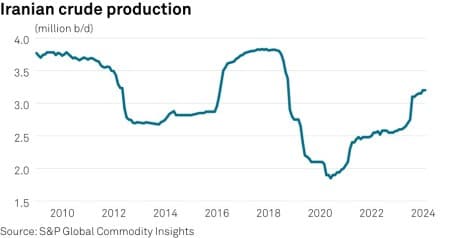
– Over the past four years, rebounding from the late Trump-era resumption of US sanctions on Tehran, Iranian crude production has almost doubled with current oil production levels around 3.2-3.3 million b/d.
– Seeing foreign investors remain wary of committing to the sanction-hit upstream sector in Iran, Tehran has sought to incentivize domestic producers to maximize oil production, handing out 13.4 billion of new service contracts this week with the aim of adding another 400,000 b/d of capacity.
– Robust domestic growth has been underpinning the upstream expansion, gasoline demand has been rising consistently and hit a record high of 955,000 b/d this month as the Iranian Nowruz New Year holiday saw extremely strong mobility figures.
– Iran exported 1.3 million b/d of crude last year, 50% up compared to 2022, and barring a steady 80,000 b/d flow to political ally Syria all its oil went to China.
7. Legacy Carmakers Back in Vogue in 2024
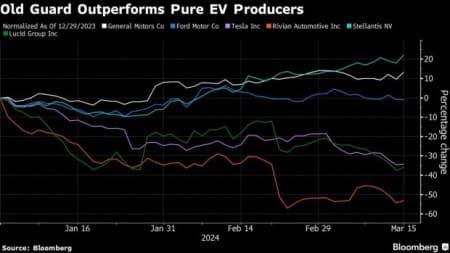
– One of the least expected facets of EV momentum losing steam is the resurgence of legacy automobile producers as gasoline-powered cars and hybrids are set to generate the vast majority of sales.
– Shares of Stellantis, a carmaking consortium encompassing Chrysler, Fiat, and Jeep, have jumped 22% on the year, triple the 7% advance in the S&P 500 index, with US peer FM rising 13% since the beginning of 2024.
– Over the same time period Tesla shares have plunged by 34%, with analysts warning of the EV carmaker’s cash flow turning negative if it slashes prices again after a whopping 25% cut to Model Y prices since early 2023.
– Dividends might also boost the appeal of traditional carmakers – Tesla doesn’t pay one and even rumors of buybacks have subsided by now – with GM, Ford, and Stellantis spending a combined $22.7 billion in stock repurchases and dividend payments.



